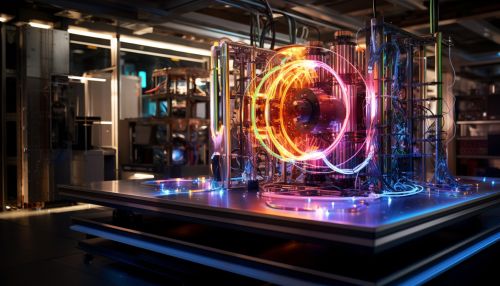Quantum Error Correction in Distributed Quantum Computing
Introduction
Quantum error correction (QEC) is a vital component of quantum computing, specifically in the realm of distributed quantum computing. It refers to the process of identifying and rectifying errors that occur in quantum systems, which are inherently susceptible to disturbances from their environment. These disturbances can lead to errors in the quantum information, which can severely impact the performance of quantum computing systems.


Quantum Errors
Quantum errors can be broadly classified into two categories: bit-flip errors and phase-flip errors. Bit-flip errors are akin to the classical bit errors, where the state of a quantum bit (or qubit) is flipped from 0 to 1 or vice versa. Phase-flip errors, on the other hand, are unique to quantum systems and involve a change in the phase of the qubit.
These errors can occur due to a variety of reasons, including environmental disturbances, imperfect control of the quantum system, and interactions between the qubits. The fragility of quantum states and their susceptibility to errors is one of the major challenges in the development of practical quantum computing systems.
Quantum Error Correction Codes
Quantum error correction codes are mathematical tools used to detect and correct errors in quantum systems. These codes work by encoding the quantum information into a larger quantum system. This encoding allows the system to detect and correct errors without directly measuring the quantum state, which would otherwise collapse the quantum state and destroy the information.
The most well-known quantum error correction code is the Shor code, named after Peter Shor, who first proposed it. The Shor code can correct both bit-flip and phase-flip errors. Other notable quantum error correction codes include the Steane code and the surface code, each with its own strengths and weaknesses.
Distributed Quantum Computing and Quantum Error Correction
Distributed quantum computing is a paradigm of quantum computing where quantum information is processed and stored across multiple quantum systems that are physically separated. This approach has several advantages, including increased robustness and scalability.
However, distributed quantum computing also presents additional challenges for quantum error correction. The physical separation of the quantum systems introduces additional sources of errors, such as communication errors during the transmission of quantum information between the systems. Furthermore, the increased complexity of distributed quantum systems can make error correction more challenging.
Despite these challenges, several quantum error correction schemes have been proposed for distributed quantum computing. These schemes often involve the use of quantum entanglement and quantum teleportation to detect and correct errors across the distributed system.
Conclusion
Quantum error correction is a crucial aspect of quantum computing, and even more so in distributed quantum computing. While the challenges are significant, the development of effective quantum error correction schemes is a vibrant area of research. The successful implementation of these schemes will be a key step towards the realization of practical, large-scale quantum computing systems.
